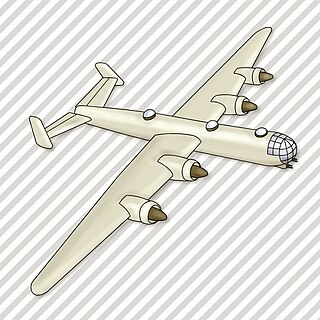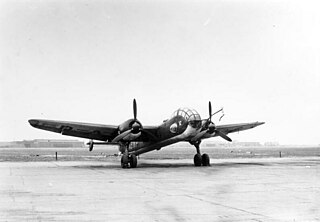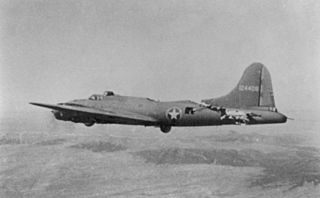
The Heinkel He 111 is a German airliner and bomber designed by Siegfried and Walter Günter at Heinkel Flugzeugwerke in 1934. Through development, it was described as a "wolf in sheep's clothing". Due to restrictions placed on Germany after the First World War prohibiting bombers, it was presented solely as a civil airliner, although from conception the design was intended to provide the nascent Luftwaffe with a heavy bomber.

The Heinkel He 219 Uhu ("Eagle-Owl") is a night fighter that served with the German Luftwaffe in the later stages of World War II. A relatively sophisticated design, the He 219 possessed a variety of innovations, including Lichtenstein SN-2 advanced VHF-band intercept radar, also used on the Ju 88G and Bf 110G night fighters. It was also the first operational military aircraft to be equipped with ejection seats and the first operational German World War II-era aircraft with tricycle landing gear. Had the Uhu been available in quantity, it might have had a significant effect on the strategic night bombing offensive of the Royal Air Force; however, only 294 of all models were built by the end of the war and these saw only limited service. Ernst-Wilhelm Modrow was the leading night fighter ace on the He 219. Modrow was credited with 33 of his 34 night air victories on the type.

The Arado Ar 234 Blitz is a jet-powered bomber designed and produced by the German aircraft manufacturer Arado. It was the world's first operational turbojet-powered bomber, seeing service during the final years of the Second World War.

The Heinkel He 177 Greif (Griffin) was a long-range heavy bomber flown by the Luftwaffe during World War II. The introduction of the He 177 to combat operations was significantly delayed, by both problems with the development of its engines and frequent changes to its intended role. Nevertheless, it was the only long-range, heavy bomber to become operational with the Luftwaffe during the war. The He 177 had a payload/range capability similar to that of four-engined heavy bombers used by the Allies in the European theatre.

The Heinkel He 274 was a German heavy bomber design developed during World War II, purpose-designed for high-altitude bombing with pressurized crew accommodation. Due to the Allied advance through Northwest Europe, the prototypes were abandoned at the French factory where they were being built. They were completed after the war by the French and used for high-altitude research.

The Heinkel He 277 was a four-engine, long-range heavy bomber design, originating as a derivative of the He 177, intended for production and use by the German Luftwaffe during World War II. The main difference was in its engines. While the He 177 used four engines in two coupled pairs which proved troublesome, the He 277 was intended to use four unitized BMW 801E 14-cylinder radial engines, in single nacelle installations.

The Henschel Hs 132 was a World War II dive bomber and interceptor aircraft of the German Luftwaffe that never saw service. The unorthodox design featured a top-mounted BMW 003 jet engine and the pilot in a prone position. The Soviet Army occupied the factory just as the Hs 132 V1 was nearing flight testing, the V2 and V3 being 80% and 75% completed.

The Norden Mk. XV, known as the Norden M series in U.S. Army service, is a bombsight that was used by the United States Army Air Forces (USAAF) and the United States Navy during World War II, and the United States Air Force in the Korean and the Vietnam Wars. It was an early tachometric design that directly measured the aircraft's ground speed and direction, which older bombsights could only estimate with lengthy manual procedures. The Norden further improved on older designs by using an analog computer that continuously recalculated the bomb's impact point based on changing flight conditions, and an autopilot that reacted quickly and accurately to changes in the wind or other effects.

Bomber B was a German military aircraft design competition organised just before the start of World War II intended to develop a second-generation high-speed bomber for the Luftwaffe. The new designs would be a direct successor to the Schnellbomber philosophy of the Dornier Do 17 and Junkers Ju 88, relying on high speed as its primary defence. Bomber B would be a much larger and more capable aircraft, with range and payload far greater than the Schnellbomber, surpassing the largest conventional designs then under consideration. The winning design was intended to form the backbone of the Luftwaffe's bomber force, replacing the wide collection of semi-specialized designs then in service. The Reich Air Ministry was so optimistic that more modest projects were generally cancelled; when the project failed the Luftwaffe was left with hopelessly outdated aircraft.

The Dornier Do 19 was a German four-engine heavy bomber that first flew on 28 October 1936. Only one prototype flew, and it was converted to a transport in 1938. The other two were scrapped.

The Emergency Fighter Program was the program that resulted from a decision taken on July 3, 1944 by the Luftwaffe regarding the German aircraft manufacturing companies during the last year of the Third Reich.

A bombsight is a device used by military aircraft to drop bombs accurately. Bombsights, a feature of combat aircraft since World War I, were first found on purpose-designed bomber aircraft and then moved to fighter-bombers and modern tactical aircraft as those aircraft took up the brunt of the bombing role.

The Stabilised Automatic Bomb Sight (SABS) was a Royal Air Force bombsight used in small numbers during World War II. The system worked along similar tachometric principles as the more famous Norden bombsight, but was somewhat simpler, lacking the Norden's autopilot feature.

The Mark XIV Bomb Sight was a bombsight developed by Royal Air Force (RAF) Bomber Command during the Second World War. It was also known as the Blackett sight after its primary inventor, P. M. S. Blackett. Production of a slightly modified version was also undertaken in the United States as the Sperry T-1, which was interchangeable with the UK-built version. It was the RAF's standard bombsight for the second half of the war.
A pilot direction indicator or pilot's directional indicator (PDI) is an aircraft instrument used by bombardiers to indicate heading changes to the pilot in order to direct them to the proper location to drop bombs. The PDI is used in aircraft where the pilot and bombardier are physically separated and cannot easily see each other.
The gyroscopic autopilot was a type of autopilot system developed primarily for aviation uses in the early 20th century. Since then, the principles of this autopilot has been the basis of many different aircraft control systems, both military and civilian.

The All American was a World War II Boeing B-17F Flying Fortress heavy bomber that was able to return safely to its base after having its rear fuselage nearly cut off by an in-flight collision with a German Bf 109 over enemy-held territory. The bomber's flight is said to have yielded one of the most famous photographs of World War II, and has been linked with the phrase "Comin' in on a Wing and a Prayer." It inspired the 414th Bombardment Squadron's emblem, an image of a puppy praying atop an aircraft's tail section.

The Messerschmitt Me 262 was a German World War II fighter aircraft built by Messerschmitt in the later stages of the war, and under license by Avia post-war.
The Dornier Do 417 was a twin-engine multirole combat aircraft. Developed in 1942, it resulted from the Luftwaffe's request for a medium bomber, a contest in which Dornier, Junkers, Heinkel, and Blohm & Voss competed. In the end, the Junkers Ju 188 was chosen by the Luftwaffe, and the Do 417 never entered production.

















